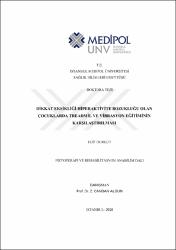Dikkat eksikliği hiperaktivite bozukluğu olan çocuklarda treadmil ve vibrasyon eğitiminin karşılaştırılması
Künye
Durgut, E. (2018). Dikkat eksikliği hiperaktivite bozukluğu olan çocuklarda treadmil ve vibrasyon eğitiminin karşılaştırılması. (Yayınlanmamış doktora tezi). İstanbul Medipol Üniversitesi Sağlık Bilimleri Enstitüsü, İstanbul.Özet
Çalışmanın amacı, Dikkat Eksikliği Hiperaktivite Bozukluğu (DEHB) olan çocuklarda treadmil eğitimi ile tüm vücut vibrasyonu (TVV) eğitiminin denge, dikkat, DEHB ile ilişkili davranışlar ve yaşam kalitesi üzerine etkilerini karşılaştırmaktır. DEHB tanısı almış 7-11 yaş arası 30 olgu, randomize olarak iki gruba ayrıldı. Çalışma grubu (n=15) 8 hafta, 3 gün/hafta, günde 45 dakika treadmil eğitimi ile birlikte 15 dakika TVV eğitimine alındı. Kontrol grubuna (n=15) 8 hafta, 3gün/hafta, günde 45 dakika sadece treadmil eğitimi verildi. Değerlendirmeler eğitim programına başlamadan önce ve 8. haftanın sonunda yapıldı. Olguların vücut kompozisyonu ölçümü Omron cihazı ile, dengeleri Pediatrik Denge Skalası (PDS) ve Biodex Denge Sistemi cihazı ile, dikkatleri Stroop Testi TBAG Formu ile, ev ve sınıf içi davranışları Yönetici İşlevlere Yönelik Davranış Derecelendirme Envanteri (YİYDDE)-Ebeveyn ve Öğretmen Formu, Conners Ebeveyn Değerlendirme Ölçeği-Yenilenmiş/Uzun Formu (CEDÖ-Y/U) ve Conners Öğretmen Değerlendirme Ölçeği-Yenilenmiş/Uzun Formu(CÖDÖ-Y/U) ile, yaşam kalitesi Çocuklar İçin Yaşam Kalitesi Ölçeği (ÇİYKÖ)-Çocuk ve Ebeveyn Formu ile değerlendirildi. Eğitim sonunda her iki grupta da tüm değerlendirmelerde anlamlı gelişmeler elde edildi. Gruplar arasında stabilite limitleri testi-genel skoru, dengenin duyusal entegrasyonu testi-gözler kapalı/sert zemin skoru ve dinamik tek ayak stabilite testinin tüm skorlarında, CÖDÖ-Y/U ve YİYDDE-Öğretmen Formu puanlarında elde edilen gelişmeler açısından çalışma grubu lehine anlamlı fark bulundu (p<0,05). Sonuç olarak; TVV eğitiminin DEHB olan çocuklarda dinamik denge ve sınıf içi davranışları üzerinde treadmil eğitimine ek faydalar sağlayabileceği belirlendi. Bu sonuçlar ile DEHB olan çocukların tedavisinde egzersiz eğitiminin faydalı bir tedavi yaklaşımı olabileceği gösterildi. The aim of the study was to compare the effects of treadmill and whole body vibration (WBV) trainings on balance, attention, attention deficit hyperactivity disorder (ADHD) related behaviours and quality of life in children with ADHD. 30 subjects aged between 7 and 11 years who are diagnosed with ADHD were randomised into two groups. Experimental group (n=15) received treadmill training for 8 weeks, 3 days per week and each session for 45 mins, and additionally WBV training for 15 mins. Control group (n=15) received only treadmill training for 8 weeks, 3 days per week and each session for 45 mins. Assessments were applied before the beginning of the training program and at the end of 8th week. The body composition of subjects was measured with Omron device; balance with Pediatric Balance Scale (PBS) and Biodex Balance System Device; the attention with Stroop Test; in-home and classroom behaviours with Behaviour Rating Inventory of Executive Function (BRIEF)-Parents and Teacher Form, Conners' Parent Rating Scale-Revised/Long Form (CPRS-R/L) and Conners' Teacher Rating Scale-Revised/Long Form (CTRS-R/L); quality of life with the Pediatric Quality of Life Inventory (PedsQL) –Children and Parents Form. At the end of the training program, all the assessment results improved significantly in both groups (p<0,05). There were significant differences between groups regarding improvements on limits of stability testing-overall score, sensory integration and balance testing- eyes closed-firm surface and all of the scores of dynamic single leg stability testing and CTRS-R/L and BRIEF- teacher form in favor of the experimental group. In conclusion, addition of WBV to treadmill training may provide further improvements in dynamic balance and classroom behaviours for children with ADHD compared to treadmill training alone. This study showed that exercise training may be a beneficial treatment approach for children with ADHD.
Koleksiyonlar
- Tez Koleksiyonu [1159]


















